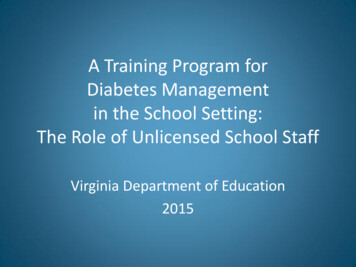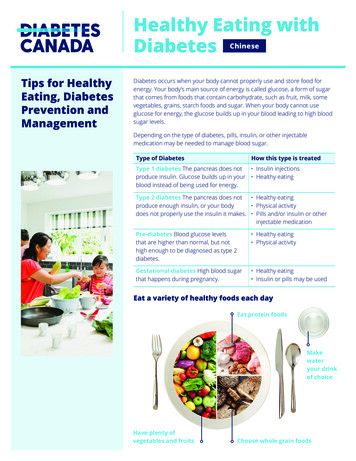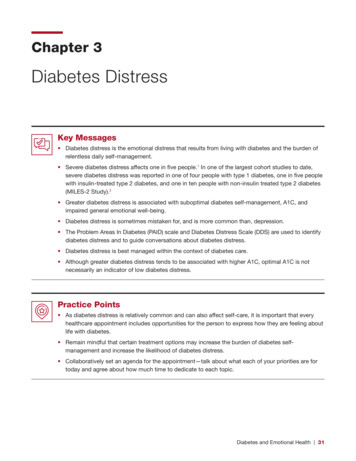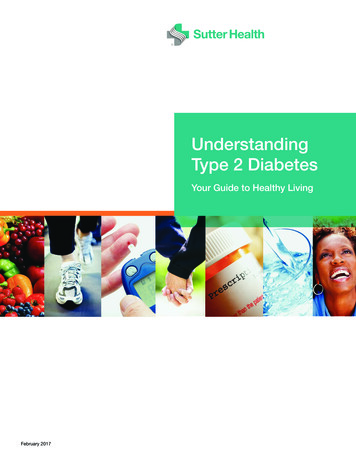
Transcription
A Training Program forDiabetes Managementin the School Setting:The Role of Unlicensed School StaffVirginia Department of Education2015
Objectives To understand legal authorization andprotection for unlicensed persons renderingcare To provide an overview of diabetes To demonstrate specific daily and emergencymanagement requirements To reinforce the importance of proper parentnotification and documentation of care
Legislative Authorization COV § 54.1-2901(A)(13)(20)(26): allowstrained unlicensed persons to give insulin andglucagon § 22.1-274 Requires schools to haveemployees trained in the administration ofinsulin and glucagon when a school nurse isnot present Good Samaritan Act (§ 8.01-225.A.9) Protectspersons rendering emergency care
Rights and ResponsibilitiesThe rights and responsibilities of the student,physician, parent or guardian, administrator, andthe trainee shall be consistent with relevantstate and federal laws and local school boardpolicy.
Levels of Care Level 1: All school personnel receive training Level 2: Classroom teachers and personnelcaring for the student throughout the schoolday Level 3: Staff receiving in-depth training tomanage diabetes and emergency care forstudent with diabetes
DIABETES Diabetes is a “disorder of metabolism” where glucose, the body’senergy source, is unable to be transported into cells because of aproblem with a hormone called insulin. In people who have diabetes, the body does not make or use insulinproperly. Glucose builds up unused. Because the body is not usingthe glucose, high levels of glucose build up in the blood. If the body no longer makes insulin, an alternate source of insulinmust be provided by injection. If the body has, but does not useinsulin properly, individuals may take insulin and/or other glucoselowering medications. Insulin and other diabetes medications are used to manage bloodglucose levels; but they do not provide a cure for the disease.
Type 1 Diabetes In Type 1 diabetes, which is typically found inchildren and adolescents, the body does notmake insulin Outside sources of insulin are needed tomaintain normal glucose levels Poorly controlled Type 1 diabetes createsserious damage to many body systems
Type 2 Diabetes In Type 2 diabetes, which is typically found inoverweight adults over 40, insulin is presentbut is not working properly The obesity epidemic in the US coincides withchildren developing Type 2 diabetes The same problems with body systems canoccur with Type 2 as with Type 1
Symptoms of Diabetes FatigueIncreased thirstIncreased urinationNauseaRapid weight lossBlurred visionFrequent infectionsSlow healing of wounds or sores
Authorization for TreatmentIn order to treat a child or adolescent withdiabetes in school, the following is needed:– Documentation of the diagnosis with a writtenDiabetes Medical Management Plan (DMMP)– Authorization for treatment by a prescriberlicensed to practice medicine in the US– Written parent permission
PRINCIPLES OF MEDICATIONADMINISTRATIONThe “five rights” of giving medication are: Right student Right medication Right dose Right time Right route (by mouth, injection, etc.)
Documentation: The Sixth RightDocumentation includes: the name of person administering the medication the name of student receiving the medication the name of the medication the time it was given the dose given the route or manner in which it was delivered(e.g., oral, subcutaneous, intramuscular) any unusual observations or circumstances
Medication Storage All medications require proper storage in a securecabinet, drawer, closet, or refrigerator All three U.S. insulin manufacturers recommendthat insulin be stored in a refrigerator atapproximately 36 F to 46 F Insulin products contained in vials or cartridgessupplied by the manufacturers (opened orunopened) may be left unrefrigerated at atemperature between 59 F and 86 F for up to 28days and continue to work
Individualized Care PlansThere are three types of care plans: Individualized Health Care Plan (IHP) Emergency Action Plan (EAP) Diabetes Medical Management Plan (DMMP)
Therapeutic Management of Diabetes The parent needs to provide essentials supplies,necessary to implement the DMMP and tosustain a student’s needs for at least 72 hours Dependent students will house supplies in theschool health office and replenished by theparent as they are used Independent students will carry some supplies ina diabetes kit and should keep back-up suppliesin the health office
Monitoring the Student with DiabetesTesting Blood Glucose Before eating snacks or lunch, Before physical activity, Before leaving school on the bus, As needed, such as when the student hassymptoms of either a high or low BG, Anytime as written in the DMMP
Blood Glucose Testing Know the instructions to the type of meter thestudent is using If you are uncertain how to use or read themeter, seek guidance from your nursesupervisor or building administrator Learn how to ensure correct operation foraccurate readings, proper cleaning, batteryreplacement and safe storage Never share meters between students
Procedure for Blood Glucose Testing Review directions on operation and use of meterWash and dry hands and put on non-latex glovesHave student wash and dry handsAssemble supplies, turn on meter, place test stripin device per manufacturer instructions Select test site, such as side of fingertip. Hangarm down for 30 seconds.
Blood Glucose Testing Continued Put the device lancet on finger tip permanufacturer instructions, fire lancet and liftaway, then gently milk finger down to obtaindrop of blood to cover the test pad on the teststrip and read per instructions Compress lanced area with tissue or cottonball Record and compare reading to DMMPinstructions
Procedures for Urine Testing Review directions for urine ketone testing, if not familiarwith them. Wash hands. Don non-latex gloves Gather supplies:– bottle of ketone test strips (check expiration date)– urine cup– gloves, if caregiver performing the test– clock or watch with second hand Have student urinate into cup. Ideally student shouldhandle urine and conduct testing if that is part of theDMMP. Dip the test strip into the urine and shake off excess urine,or observe the student doing same.
Urine Testing Continued Wait the specified amount of time in thedirections on the bottle of test strips, usually 15seconds. Read the results by comparing the color on thetest strip to the chart on the bottle. Record the results on the student’s log and takeaction per the DMMP. Dispose of test strip, remove gloves, wash hands
Diabetes and Nutrition According to the NDEP (2010, p. 50), thesignificant difference in meal planning for thestudent with diabetes is that the timing, amount,and content of the food eaten are carefullymatched to the timing, dosing, and action of theinsulin The nutritional component of diabetesmanagement should be in the DMMP. Staffassisting students with tracking of food mustbecome familiar with carbohydrate calculations
Carbohydrate Counting Adults assisting students with diabetes mustremember it is important to read the labels onALL foods to determine the number ofservings in a container and the number ofgrams of carbs per serving
Sample Calculation ofan Insulin to Carb Ratio The student’s lunchtime insulin-to-carb ratio is1:15 The child ate 60 grams of carbs. The formulais: 60 15 4 units of insulin
Correction FactorThe correction factor is the amount of insulin thestudent needs to lower the BG into target range.The target BG is subtracted from the actual premeal BG. The prescriber will specify how muchinsulin is required for results that are over thetarget BG. This calculation is student-specific andmay vary.
Sample Calculation of a CorrectionDoseThe student’s pre-meal BG is 300. The student’starget BG is 150. The correction dose is 1 unit ofinsulin for every 50 mg/dL over 150. Theformula is:300 – 150 150 50 3 units of insulin
Total Insulin Dose Insulin-to-carb dose plus correction dose total units of insulin needed: The formula is:4 3 7 units of rapid-acting insulin
Exercise Affects Insulin RequirementsThe student with diabetes should eat prior toexercising if it has been more than two hourssince the student has eaten, or as directed in theDMMP.
Insulin AdministrationTypes of Insulin According to the FDA (2015), there are fourbasic types of insulin, each is classed by how itworks:– Rapid-acting - Humalog , Novolog , Apidra– Short-acting – Regular (Humulin R, Novolin R)– Intermediate-acting – NPH (Humulin N, NovolinN)– Long-acting - Glargine (Lantus), Detemir (Levemir)
VocabularyTarget Range: A range of numbers that represents anindividual’s ideal blood glucose level; determined by healthcare team with the individual (child with diabetes andparent/guardian)Basal Insulin: Sometimes called "background" insulin, theinsulin working steadily throughout the dayBolus Insulin: a single dose of insulin, given for one of tworeasons: Carb or Meal/Snack Bolus: Insulin dosed when food iseaten Correction Bolus: Insulin dosed when blood glucose levelis too high and needs to be corrected (made lower)
Insulin Delivery Methods Insulin Syringe Insulin Pen Insulin Pump or Pod
Measuring Insulin Doses Insulin doses are measured in “units”One vial of insulin contains 10 ml of insulin10 ml of insulin is equivalent to 1000 unitsTherefore 1 ml of insulin equals 100 unitsDECIMALS AND ZEROS MATTERIN MEASURING INSULIN!
Calculating and MeasuringTotal Insulin Dose-Quiz If the insulin-to-carb dose is 4 And the correction dose is 3 And we know this combination total units ofinsulin needed How many units of rapid-acting insulin areneeded as a correction factor? How many milliliters of insulin would youdraw out of a 10 ml vial of insulin to get thecorrect number of units?
Question Insulin to carb dose is4 Plus correction dose of 3 Total correction dose is 7 units of insulinYou have 10 ml of insulin in an unopened vial.You know 1 ml equals 100 units of insulin.You only need 7 units.How do you calculate the number of ml of insulin todraw up in your syringe?
Solution1 ml100 units:X ml7 units1 x 7 7 100 x X 100XTherefore 7100 .07 ml
Common Steps forAll Types of Injections Wash hands and put on non-latex gloves. Ifstudent is assisting, have student wash hands. Assemble essential supplies specific to themethod of delivery and insulin per DMMP. Warm cold insulin.
Common Steps forAll Types of Injections Never recap or reuse a dirty needle and useextreme caution to avoid needle sticks to selfor others. Discard used needles and syringes in a usedsharps container. Remove and discard usedgloves. Document appropriately.
Insulin by vial, needle, and syringe Check (and double check) that insulin typeand brand matches order Check expiration date Remove metal cover, and swipe rubber capwith alcohol wipe Fill syringe with air equal to the number ofunits of insulin needed Plunge into the vial and inject the air
Insulin by vial, needle, and syringe Fill syringe with appropriate dose of insulinand double check your numbers Prep site on skin with alcohol and let dry Inject insulin
Insulin by Insulin Pen
Insulin Pens Check the level of insulin remaining in the insulin cartridge. Attach new needle. Prime the needle. Dial in prescribed dose. Cleanse the skin with alcohol and allow the skin to dry beforeadministering. Pinch up the skin at the site and dart the needle into the soft pocketat 90 angle. Push the plunger down and inject insulin at a steady rate. Release the pinched up skin. Count slowly to 5 and then removethe needle. Secure the pen.
Administering Insulin by Insulin Pump Decreases the risk of long-term complicationsReduces symptoms of diabetesPromotes normal growth and developmentPromotes positive family adaptationAllows individual to lead a more normal lifestyle
Components of the Insulin PumpTherapy system1. Insulin Pump2. Reservoir3. Infusion Set
Pump Operations Basal rate: This will not be changed at school. Bolus dose - delivered by child/nurse to covercarbohydrates eaten and/or to correct forhyperglycemia. This will be done in schoolmultiple times per day:–Food doses are given whenever carbs areconsumed–Correction doses cannot be given more often thanevery 2 hours
The pump has a compartment to hold the reservoir. The reservoir is filled with insulin.(may be disposable) A thin tube attaches to the reservoir which is put into the pump and alsoattaches to the infusion set.The infusion set tube inserts intothe body through a tiny needle orflexible tube (cannula) under theskin.The insulin is pumped from thereservoir through the infusion set tothe body continuously through theday.
Blood Glucose ValuesResultFasting Plasma Glucose (FPG)Normalless than 100 mg/dlPre-diabetes100 mg/dl to 125 mg/dlDiabetes126 mg/dl or higher
Symptoms of HyperglycemiaMild Increased thirstFrequent urinationFatigue/sleepinessIncreased hungerLoss of concentrationBlurred visionUrine ketones (0-small)Moderate Sweet smelling breathDry mouthNauseaStomach crampsVomitingUrine Ketones (Moderate-Large)Severe Labored breathingVery weakConfusedUnconsciousUrine ketones (Moderate-Large)
Treating HyperglycemiaMild1.2.3.4.Drink zero-calorie fluids (i.e. water)Check urine ketonesDecrease activity if ketones presentNotify parentsModerate1. Drink zero-calorie fluids(i.e. water)2. Check urine ketones3. If ketones are present, decrease activity,call the doctor, administer anti-nauseasuppository if prescribed4. Notify parentsSevere1.2.3.Call 911Notify parentsNotify health care provider if parentcannot be reached
Hypoglycemia Low blood sugar can develop within minutesand requires immediate attention. If “low bloodsugar” is suspected, staff should not leave thechild unattended at any time. HYPOGLYCEMIA IS A MEDICAL EMERGENCYTHAT REQUIRES IMMEDIATE ACTION WITH ASUGAR CONTAINING PRODUCT OR GLUCAGONFOLLOWING THE DMMP AND/OR EMERGENCYACTION PLAN.
Mild/ModerateSymptoms of nessweaknessdizzinesscold, clammy skinhungerdrowsinesssweatingpalenessrapid heart beatvisual disturbancestelling you “I feel low”– complaining of “feelingfunny”– numbness or tingling oflips– yawning– headache– confusion– inability to concentrate– changes in behavior(irritability, crying,combativeness)– slurred speech– nausea
Severe Symptoms– inability to swallow– unconsciousness (extreme cases)– seizures (extreme cases)
Treatment of Hypoglycemia For students who can swallow, follow the “Rule of 15” Treat with 15 grams of a fast-acting carbohydrate source Wait 15 minutes, then, recheck the blood sugar. If the blood sugar is less than the target range in the DMMP keeprepeating the 15 grams of carbohydrate and rechecking blood sugarlevel 15 minutes later until the BG level is back in the desired range. Contact 911 and notify the parents immediately if blood glucose is notresponding to your efforts or if the student worsens in symptoms OR If the blood sugar level is back in the target range per the DMMP, givea snack or meal as ordered in the DMMP.
Glucagon
Glucagon Verify signs of severe low blood glucose. Do not delay treatment pendingBG testing if any of the signs or symptoms of hypoglycemia are noted:–––––unable to swallowunconsciouscombativeuncooperativehaving seizures Call or ask someone to call 911. Do not leave individual unattended. Position child on his/her side in a safe area with head positioned to theside. Administer glucagon per Emergency Action Plan. After administration of glucagon, as the child regains consciousness,nausea and vomiting usually occurs and the student must be kept onhis/her side to prevent choking.
If Glucagon is Not AvailableIf student is unconscious or seizing, andglucagon is not available, this is aMEDICAL EMERGENCY– Roll student on side– Squirt glucose gel, frosting, honey, or othersuitable glucose source onto gums taking care notto put hands in students mouth– Call 911 and stay with student, repeating glucosesquirts on gums until help arrives
DISPOSAL OF MEDICAL SUPPLIES Used needles, syringes, and lancets must bedisposed of in a properly labeled biohazardsharps container as they are used. Know your local school division’s policies andprotocols regarding disposal of medicationsand syringes.
Documentation Documentation is commonly considered the“sixth right” of medication administration All care given to a student with diabetes mustbe recorded in the student’s cumulativemedical record Documentation is the legal record the schoolstaff has given the properly authorizedmedication and/or performed procedures oressential interventions
Emergency Action Plans Written by a school nurse Written for unlicensed persons to follow incase of an emergency Provides clear, simple and conciseinstructions, such as “If you see this , then dothis ”.
Blood Exposures or Accidental Sticks Use Standard (Universal) Precautions Use Judicious Avoidance Use scrupulous handwashing and non-latexgloves Report suspected or confirmed exposuresimmediately.
Medication Errors Insulin is a high hazard medicine Insulin errors are all emergencies Seek medical assistance immediately
Reference Manual for Training Public School Employeesin the Administration of Insulin and Glucagon(Rev. July 2015) medication/manual training insulinglucagon.pdf.
trained unlicensed persons to give insulin and glucagon § 22.1-274 Requires schools to have employees trained in the administration of insulin and glucagon when a school nurse is . -Long-acting - Glargine (Lantus), Detemir (Levemir) Vocabulary Target Range: A range of numbers that represents an individual's ideal blood glucose level .











